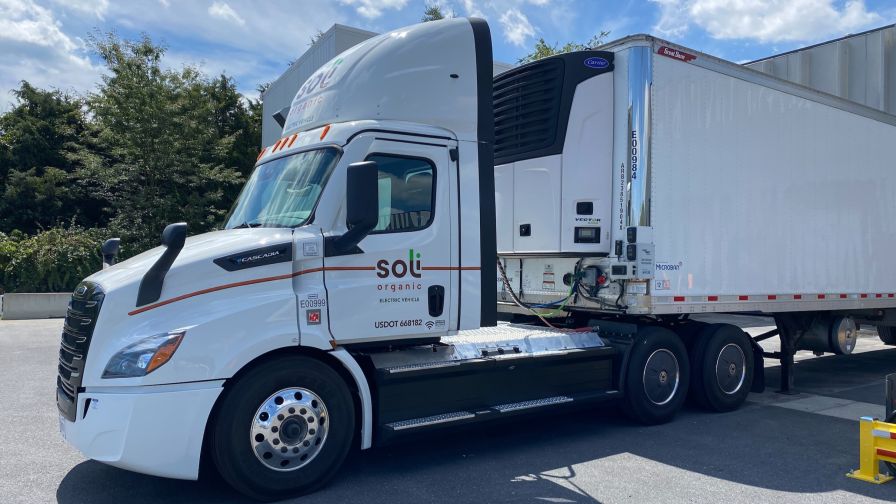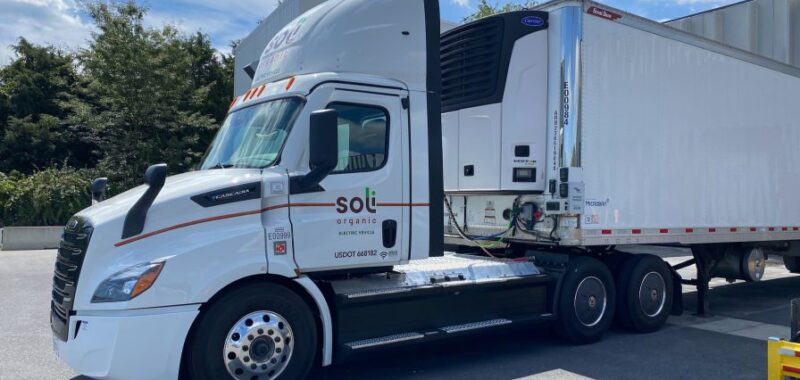
Freightliner eCascadia EV from Penske Truck Leasing | Soli Organic
Recently, our sister brand of CEAg World (under the Meister Media Worldwide umbrella) highlighted Soli Organic’s recent partnership with a truck company to test out an all-electric delivery truck. Here’s a look at their coverage:
For nearly 40 years, Soli Organic has been committed to growing leafy greens and herbs sustainably. On Aug. 14, 2024, the company deepened that commitment to the industry with the launch of a partnership and test project with Penske Truck Leasing. The goal of this collaboration is to deploy the Freightliner eCascadia, a battery-operated truck that will deliver Soli Organic’s greens to its customers in a sustainable way.
Electric Vehicles Have Been a Long Time Coming
Launching a battery-operated truck, or electric vehicle (EV), has been a goal of Soli Organic for quite some time. After meeting with Penske’s sustainability team at the Advanced Clean Transportation (ACT) Expo earlier this year, Soli discovered they both value making carbon-intensive industries more sustainable. By combining Penske’s expertise in trucking and Soli Organic’s sustainably grown leafy greens and herbs, they will be able to distribute high-quality, organic produce to their retail partners while reducing their environmental impact.
“It’s a good partnership for both of us,” says Jeffrey Saunders, Vice President of National Logistics at Soli Organic. “It really allows us to see what the capabilities of electric vehicles are. Penske knows that improving sustainability within our fleet and reducing our carbon footprint is very important. We’ve had multiple conversations with them about that, and they’ve been an incredible partner.”
While the EV is operating in a pilot test for six months, Saunders is optimistic about the data they have collected during its first 30 days.
“We’re encouraged about the possibilities of what this could mean for our fleet,” says Saunders. “We want to have a positive impact in this area for sustainability, and this is a step in the right direction.”
Traversing Over Rough Terrains
The six-month pilot test is taking place at Soli Organic’s headquarters in Rockingham, VA. During this time, the EV will deliver herbs and leafy greens to the company’s local retail partners.
One of the biggest factors both companies will focus on during the pilot is battery life and the different elements that affect it. Penske was especially excited about Soli’s location in the Shenandoah Valley’s hilly terrain.
“Virginia is one of our largest sites and we’re traversing over a lot of hills and mountains,” Saunders says. “We have to be sure that an EV is going to work in that type of environment.”
Prior to the commencement of the pilot test, Soli was informed the battery would provide approximately 250 miles of range under flat road conditions. As of mid-September, the electric vehicle has successfully returned to base with 30% battery life remaining after covering more than 180 miles of hilly terrain. “This brings us quite close to the 250-mile mark,” Saunders notes.
However, the EV still needs to pass several tests before it’s officially used across Soli facilities. This includes how well it carries heavier loads. The truck may primarily transport leafy greens, but there will be times when it needs to carry heavier materials for supply chain pickups.
“The heavier the load, the harder the tractor has to pull,” says Saunders. “What we handle is traditionally light – herbs and greens aren’t very heavy. We haven’t pulled anything that’s super heavy yet, but we will at some point in time.”
Figuring Out EV Charging Stations
So, what happens when the EV’s battery runs out and needs to charge? Soli is working to optimize driver routes around charging stations in the area. The company has worked closely with Penske to locate stations that are en route to its retail locations in Virginia.
Finding optimal charging stations for the battery-operated truck proved to be a challenging task for Soli. At the company’s headquarters in Virginia, they charge the truck on a Heliox AC battery charger overnight. On the road, they use 350-kilowatt electric car chargers, which usually take between one to two hours to fully recharge the battery. “Our goal is to charge 30 to 40 minutes while the driver is on break so they can make it back to the yard” – Soli wants to make sure their drivers are comfortable and have their needs met.
“We want to choose charging stations that work for our drivers,” Saunders says. “We want places that have eating areas, restrooms, and are a good place for them to take a break. Our long-term plan is to build our drivers’ schedules to make their mandatory breaks work with charging.”
In addition to optimizing routes for charging and drivers’ schedules, Soli hopes to get their product to its final destination as soon as possible.
“We want to reduce food miles,” says Saunders. “We want to get [our product] to consumers as fast as possible. That’s the long-term goal and objective, and we believe there are routes out there today we can use to do that.”
Using Data to Make Informed Decisions
During the truck’s six-month pilot test, Soli is making data collection a top priority. While there’s plenty of general information about EVs available, it comes from third-party sources; the company wants to collect data specific to its fleet.
“At Soli, we pride ourselves on making data-based decisions,” says Saunders. “In order to do that, you have to collect [data]. There’s data out there, but it doesn’t relate to what we do. We wanted to collect our own so we could really make informed decisions.”
Saunders is pleased with the results Soli has seen so far and feels hopeful about the truck’s ability to reduce their environmental impact. “We’re very excited about [the trial] and pushing to a greener future,” he adds.
The original article can be found on the CEAg World website, along with more news coverage of controlled environment agriculture.

